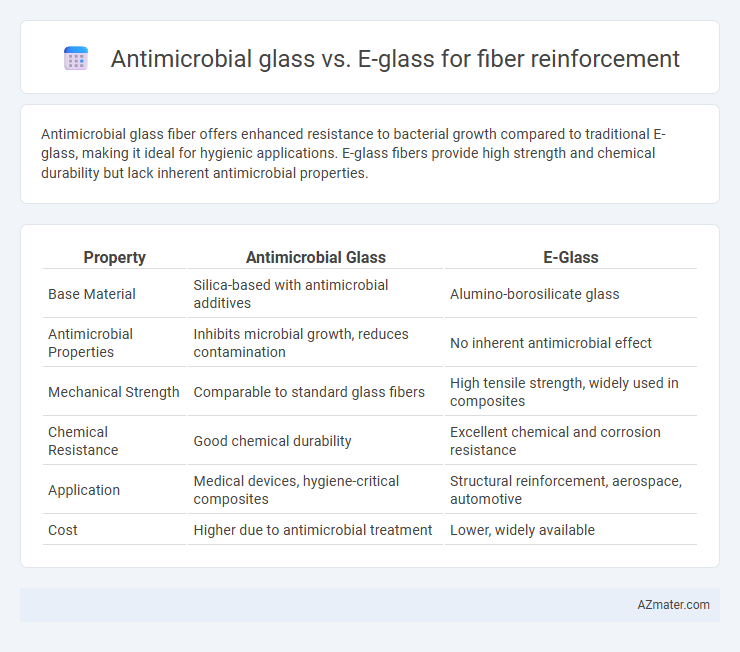Antimicrobial glass fiber offers enhanced resistance to bacterial growth compared to traditional E-glass, making it ideal for hygienic applications. E-glass fibers provide high strength and chemical durability but lack inherent antimicrobial properties.
Table of Comparison
| Property | Antimicrobial Glass | E-Glass |
|---|---|---|
| Base Material | Silica-based with antimicrobial additives | Alumino-borosilicate glass |
| Antimicrobial Properties | Inhibits microbial growth, reduces contamination | No inherent antimicrobial effect |
| Mechanical Strength | Comparable to standard glass fibers | High tensile strength, widely used in composites |
| Chemical Resistance | Good chemical durability | Excellent chemical and corrosion resistance |
| Application | Medical devices, hygiene-critical composites | Structural reinforcement, aerospace, automotive |
| Cost | Higher due to antimicrobial treatment | Lower, widely available |
Introduction to Fiber Reinforcement Glass Types
Antimicrobial glass and E-glass are two distinct types of fiber reinforcement materials used in composite manufacturing. E-glass, known for its excellent electrical insulation properties and high tensile strength, is widely utilized in applications like aerospace, automotive, and construction industries. Antimicrobial glass incorporates additives to inhibit microbial growth, enhancing the durability and hygiene of composites in medical and food-processing environments.
What is Antimicrobial Glass?
Antimicrobial glass is a type of fiber reinforcement material embedded with agents such as silver ions or copper compounds that inhibit microbial growth on its surface, enhancing hygiene and durability in various applications. Unlike traditional E-glass, which primarily offers mechanical strength and thermal resistance, antimicrobial glass actively prevents bacteria, fungi, and algae buildup, reducing contamination risks. This property makes antimicrobial glass especially valuable in medical, food processing, and water treatment industries where microbial control is critical.
Defining E-glass: Composition and Applications
E-glass, or electrical glass, is a type of fiber reinforcement primarily composed of silica (around 54-56%), alumina (12-16%), calcium oxide (16-25%), and boron oxide (5-12%), offering high strength, good electrical insulation, and chemical resistance. It is widely used in composites for automotive, aerospace, marine, and construction industries due to its cost-effectiveness and balanced mechanical properties. Compared to antimicrobial glass, E-glass focuses on structural reinforcement without inherent antimicrobial properties, making it suitable for applications where strength and durability are critical.
Key Differences: Antimicrobial Glass vs E-glass
Antimicrobial glass incorporates biocidal agents like silver ions within its matrix, providing inherent resistance to microbial growth, while E-glass primarily consists of alumino-borosilicate and offers high mechanical strength without antimicrobial properties. The key difference lies in antimicrobial glass's ability to inhibit bacteria and mold, making it ideal for hygienic applications, contrasting with E-glass's widespread use in structural reinforcement and composites due to its durability and electrical insulation. Performance-wise, antimicrobial glass may exhibit slightly different mechanical characteristics due to additive integration, whereas E-glass remains favored for uniform tensile strength and chemical resistance in fiber-reinforced composites.
Antimicrobial Properties and Their Importance
Antimicrobial glass incorporates biocidal agents that inhibit microbial growth on fiber reinforcement surfaces, significantly reducing the risk of contamination and biofilm formation in medical and hygienic applications. E-glass, while offering excellent mechanical strength and chemical resistance, lacks inherent antimicrobial properties, making it less suitable where microbial control is critical. The incorporation of antimicrobial properties in glass fibers is vital for enhancing durability, safety, and hygiene in environments requiring stringent microbial management such as healthcare, food processing, and water treatment industries.
Mechanical Strength: Comparing Antimicrobial Glass and E-glass
Antimicrobial glass and E-glass fibers differ significantly in mechanical strength, with E-glass typically exhibiting higher tensile strength and better impact resistance, making it a preferred choice for demanding structural applications. Antimicrobial glass, while offering the advantage of inhibiting microbial growth, generally has slightly lower mechanical properties due to the incorporation of metal ions or additives that enhance antimicrobial action but can affect fiber matrix uniformity. For applications where mechanical performance is critical, E-glass remains superior; however, antimicrobial glass provides a valuable balance where hygiene and mechanical integrity must be jointly maintained.
Durability and Chemical Resistance Factors
Antimicrobial glass offers enhanced durability compared to standard E-glass due to its specialized coating that resists microbial degradation, extending the lifespan of fiber-reinforced composites in harsh environments. Chemical resistance of antimicrobial glass surpasses that of E-glass by effectively preventing surface contamination and degradation caused by acids, alkalis, and solvents commonly encountered in industrial applications. The improved resistance properties make antimicrobial glass a superior option for fiber reinforcement in settings requiring prolonged exposure to aggressive chemical agents and demanding durability standards.
Best Use Cases: Antimicrobial Glass in Composite Applications
Antimicrobial glass fibers are ideal for composite applications requiring hygienic surfaces, such as medical devices, food processing equipment, and hospital fixtures, due to their ability to inhibit microbial growth and enhance safety. In contrast, E-glass fibers excel in structural reinforcement for automotive, aerospace, and construction industries where mechanical strength and cost-efficiency are paramount. Choosing antimicrobial glass over E-glass is crucial when microbial resistance and sanitation are primary performance criteria in fiber-reinforced composites.
Cost Efficiency: Antimicrobial Glass vs E-glass
Antimicrobial glass typically incurs higher production costs due to the integration of biocidal agents, increasing overall material expenses compared to standard E-glass fibers. E-glass remains more cost-efficient for fiber reinforcement applications, offering a balance of performance and affordability without specialized antimicrobial properties. Evaluating lifecycle costs, E-glass usually provides optimal economic value where antimicrobial benefits are non-essential, although antimicrobial glass may justify costs in hygiene-critical environments.
Future Trends in Fiber Reinforcement Glass Technology
Antimicrobial glass offers enhanced durability and hygiene features by integrating biocidal agents, making it ideal for medical and public environments, while E-glass remains the standard for its excellent mechanical strength and cost-effectiveness in fiber reinforcement. Future trends in fiber reinforcement glass technology are leaning towards hybrid composites that combine antimicrobial properties with E-glass fibers to achieve multifunctional performance, including improved resistance to microbial growth, corrosion, and environmental degradation. Innovations in nanotechnology and surface treatments are expected to further optimize the antimicrobial efficacy and mechanical properties of these fiber reinforcements, driving advancements in automotive, aerospace, and construction sectors.

Infographic: Antimicrobial glass vs E-glass for Fiber reinforcement
 azmater.com
azmater.com